Kuopion kaupungintalo
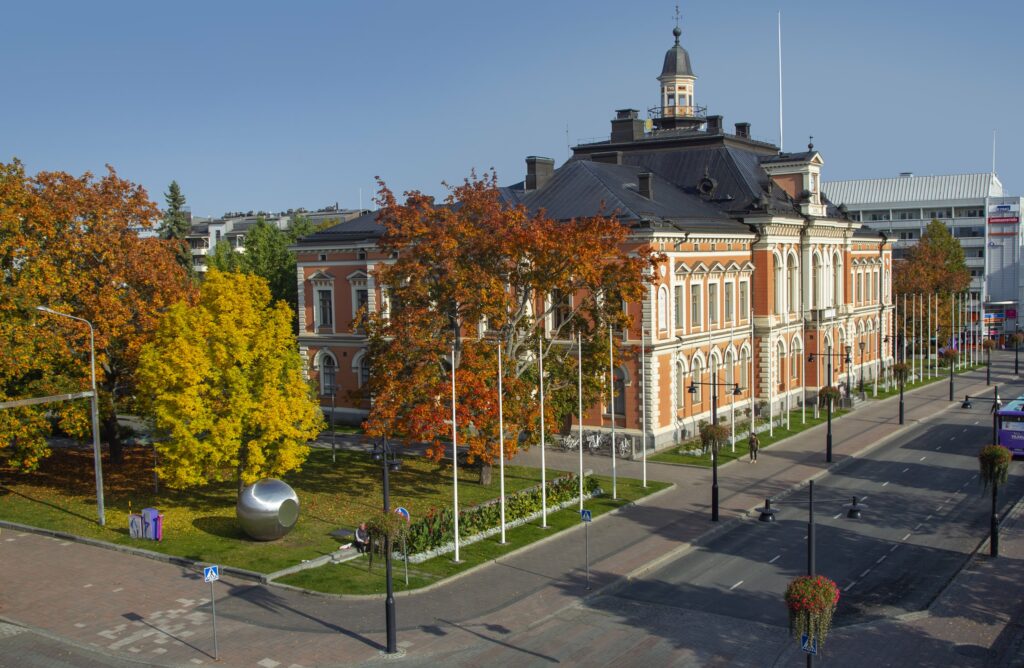
Kaupungintalon nykyinen punaruskea ulkoväritys on vuodelta 1974. Kauneimmat kunnantalot -äänestyksessä 2017 Kuopion kaupungintalo valittiin kolmen kauneimman kunnantalon joukkoon. Rakennus on suojeltu kaavalla ja se kuuluu valtakunnallisesti merkittävään rakennettuun kulttuuriympätistöön.
Vastaa kyselyyn ja vaikuta kaupungintalon tulevaan käyttöön
Eri käyttäjäryhmille suunnatulla kyselyllä halutaan kartoittaa tarpeita ja toiveita rakennuksen tulevasta käytöstä. Kaupungintaloa tullaan jatkossakin käyttämään kaupungin edustustilaisuuksissa sekä juhlakäytössä, mutta rakennusta on jatkossa mahdollista avata myös sellaisille käyttäjäryhmille ja toiminnoille, joille se ei tähän saakka ole ollut mahdollista.
Kyselyssä kartoitetaan myös ideoita tontilla sijaitsevan entisen matkailutoimistorakennuksen sekä piha-alueen tuleviin toimintoihin liittyen.
-
Rakennuksessa on aikojen kuluessa sijainnut monia toimintoja, mm. raastuvanoikeus, rahatoimikamari, poliisikamari, velkavankila, huutokauppakamari, ravintola sekä ruiskuhuone eli paloasema.
Kaupungintalolla sijaitsee nykyisin kaupunginjohtajiston työhuoneet ja vieraiden vastaanottotilat, kaupunginhallituksen kokoustila, juhlasali, ns. pieni juhlasali, neuvottelutiloja sekä kaupungin eri yksiköiden työskentelytiloja.
-
Kaupungintalon edellinen peruskorjaus on tehty 1970-luvulla, jolloin tehtiin mm. tilamuutoksia, entisöitiin sisätilojen koristemaalauksia, uusittiin taloteknisiä järjestelmiä sekä kunnostettiin ja maalattiin rakennuksen julkisivut. Rakennuksen nykyinen tekninen kunto ja siitä seuraavat korjaustarpeet edellyttävät rakennuksen peruskorjausta.
Kaupungintalon peruskorjaus voi alkaa aikaisintaan 2020-luvun loppupuolella. Ennen varsinaisen korjausprojektin käynnistymistä hankkeeseen liittyy useita suunnitteluvaiheita. Koska kaupungintalo on sekä kulttuurihistoriallisilta arvoiltaan että rakennusteknisiltä ratkaisuiltaan erityinen korjauskohde, kaikille projektin vaiheille halutaan varata riittävästi aikaa. Nyt käynnissä on kohteen tarveselvitysvaihe.
-
Rakennuksessa sijaitsevat toiminnot ovat säilyneet pitkään vakiona. Rakennuksessa on vuosien saatossa ollut kuitenkin monia eri toimintoja, ja tilojen käyttötarkoitukset ovat vaihdelleet eri aikoina. Viime vuosien aikana on noussut esiin pohdintoja siitä mitä toimintoja rakennuksessa halutaan jatkossa olevan, ja pitäisikö rakennusta avata nykyistä enemmän kaupunkilaisille, yhdistyksille ja yrityksille. Tulevien toimintojen linjaus on tehtävä rakennuksen tarveselvitysvaiheessa, jotta niiden edellyttämät tilalliset ja toiminnalliset muutostarpeet pystytään huomioimaan kohteen hankesuunnitteluvaiheessa, jossa hankkeen kustannukset pääosin määräytyvät.
Kuopion kaupungintalo rakennettiin syrjäiseen paikkaan
Kuopion kaupungintaloa ei pidä rakentaa kauppatorin laitaan syrjäiseen paikkaan kauas keskustasta. Kaupunki ei koskaan kasva niin suureksi.
Näin todettiin ja uskottiin 1880-luvun Kuopiossa. Siihen kaupungintalo kuitenkin rakennettiin vuosina 1882-1885. Uusrenessanssia edustavan rakennuksen suunnitteli arkkitehti F.A. Sjöström. Rakennustöitä johti arkkitehti Josef Stenbäck. Tyylillisesti kaupungintalo on 1800-luvun jälkipuoliskon uusrenessanssia.
Kaupungintalo on ollut monenlaisessa käytössä. Talossa on ollut muun muassa palokunnan ruiskuhuone, huutokauppasali, kirjasto lukusaleineen ja tornissa päivysti palovartija.
1970-luvun entisöinti kunnioitti vanhoja perinteitä
Sisäosat ovat vuosien aikana kokeneet monia muutoksia. Jo 1900-luvulla peitettiin katto- ja seinämaalaukset harmaalla yksivärisellä maalilla ja näitä päällemaalauksia on tehty kaikkiaan 3 – 4 kertaa.
Varsinaista entisöintiä tehtiin 1970-luvun peruskorjauksessa ala-aulassa, portaikossa, yläaulassa, juhlasalissa ja entisessä kaupunginvaltuuston istuntosalissa, joka muutettiin henkilökunnan ruokalaksi. Näissä tiloissa palautettiin entiselleen lähinnä seinä- ja kattopinnat, lattiat uusittiin entisöintinäkökohdat huomioon ottaen. Myös alkuperäistä kalustoa, mm. valaisimia palautettiin paikalleen. Vuonna 2022 ruokala remontointiin ja otettiin uudelleen käyttöön kokous- ja juhlatilana.
Sisäpuolinen peruskorjaus on viimeksi tehty vuosina 1976 – 1979. Tällöin uusittiin mm. ilmastointi, tehtiin uusia huonejärjestelyjä sekä sisämaalausten entisöinti.
“Oikeus kansaa ohjelevi. Wapautta laki vartioivi”
A. OksanenKaupungintalon länsipäädyssä on teksti “Oikeus kansaa ohjelevi” ja itäpäädyssä “Wapautta laki vartioivi”. Sanat ovat peräisin A. Oksasen runosta “Porthanin kuvapatsaan paljastettua”. Tekstit saatiin kaupungintalon seinään vasta vuonna 1900, jolloin hankittiin myös aikaisemmin hankkimatta jäänyt kello.
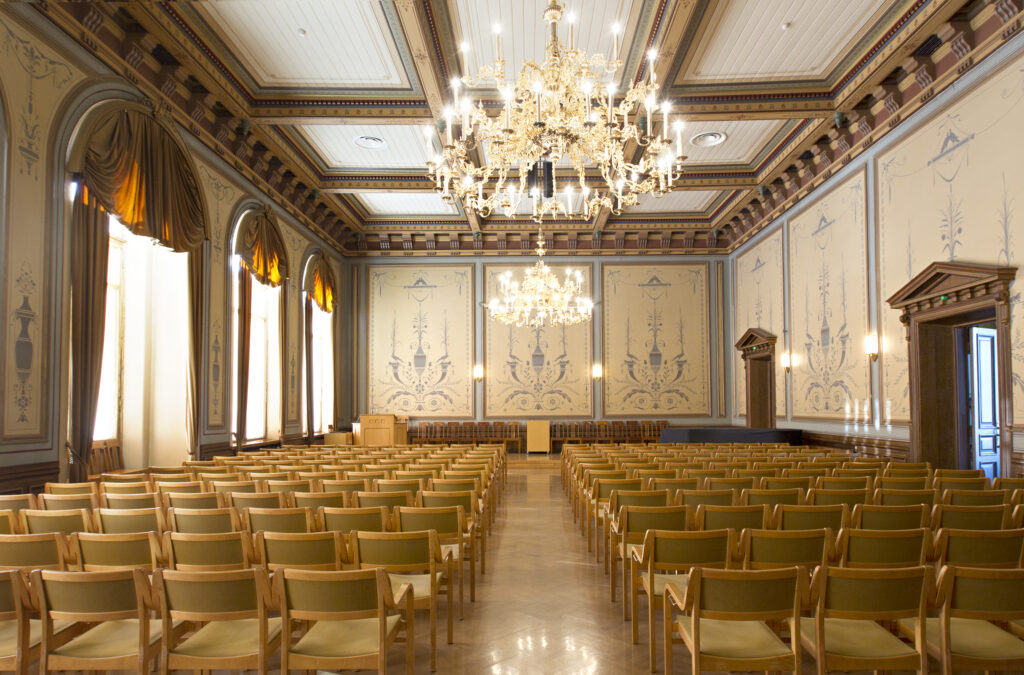
Kaupungintalo on Kuopion hallinnon keskus
Kuopion kaupungintalossa työskentelee nykyisin yli 50 henkilöä.
Kaupunginjohtajan, apulaiskaupunginjohtajien ja johdon sihteereiden työtilat ovat kaupungintalon toisessa kerroksessa. Toisessa kerroksessa kokoontuu myös kaupunginhallitus.
I kerroksessa sijaitsevat hallintopalvelu, henkilöstöpalvelu sekä markkinointi ja viestintä. Kellarikerros on varasto- ja arkistokäytössä. Ullakkotiloihin rakennettiin 1980-luvulla neuvotteluhuone aputiloineen.
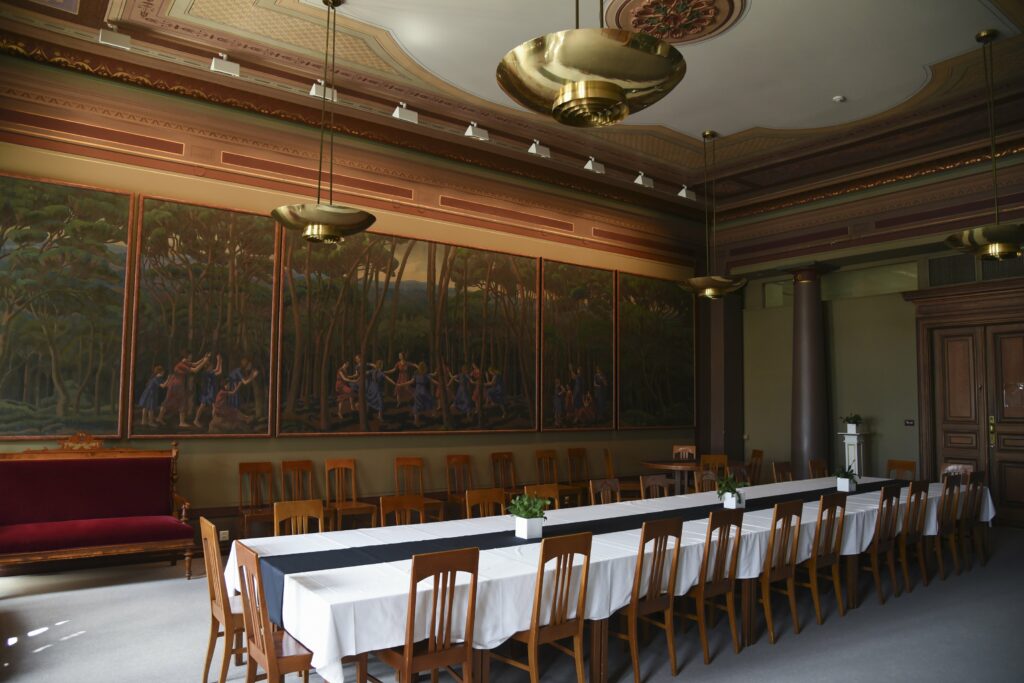
Kuopion kaupungintalon juhlasalin vuokraaminen
Voit vuokrata kaupungintalon juhlasalia vuokrausehtojen mukaisesti. Kaupungintaloa käytetään ensisijaisesti kaupungin toimisto- ja kokouskäytössä. Kaupungintalon ulkopuolisen käytön lähtökohtana on, että tilaisuus on arvokas ja kaupungintaloon soveltuva.
Ennen vuokrasopimuksen tekemistä, varmista kaupungintalon virastomestarilta joko puhelimitse tai sähköpostilla, että juhlasali on käytettävissä toivomanasi aikana.
Juhlasalin vuokraaminen
- Kuopion kaupungintalon turvainfo Tämä linkki aukeaa uuteen välilehteen
- Kaupungintalon vuokrahinnasto Tämä linkki aukeaa uuteen välilehteen
- Kaupungintalon käyttösääntö ja vuokrausehdot Tämä linkki aukeaa uuteen välilehteen
- Kuopion kaupungintalon juhlasalin vuokrasopimus Tämä linkki aukeaa uuteen välilehteen
- Kuopion kaupungintalon juhlasalin vuokravapauden hakemus Tämä linkki aukeaa uuteen välilehteen
Kaupungintalon opastuskierrokset
Kaupungintalon opastuskierroksia järjestää Kuopion oppaat ry:
guideskuopio@gmail.com, puhelin +358 44 244 3899
Esteetön kulku kaupungintalolle
Soita ja sovi tapaaminen kansliaan tai soita tarvittaessa ovien avauksesta virastomestarille 044 718 2072.
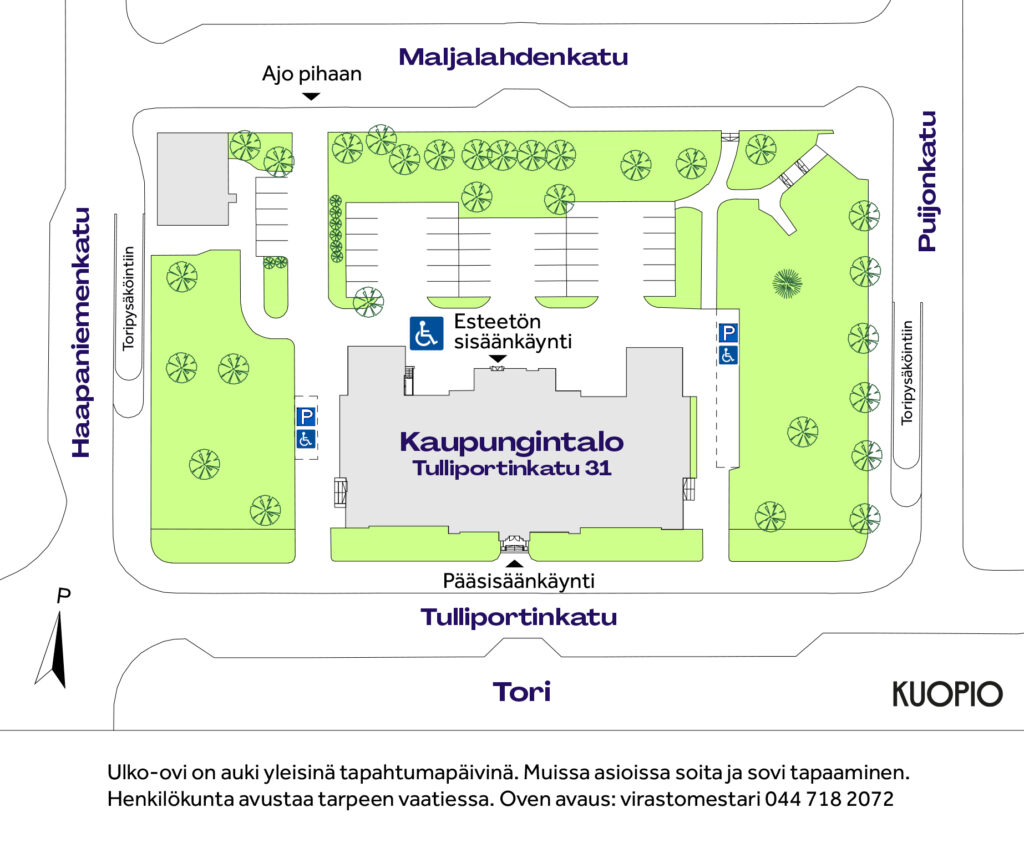
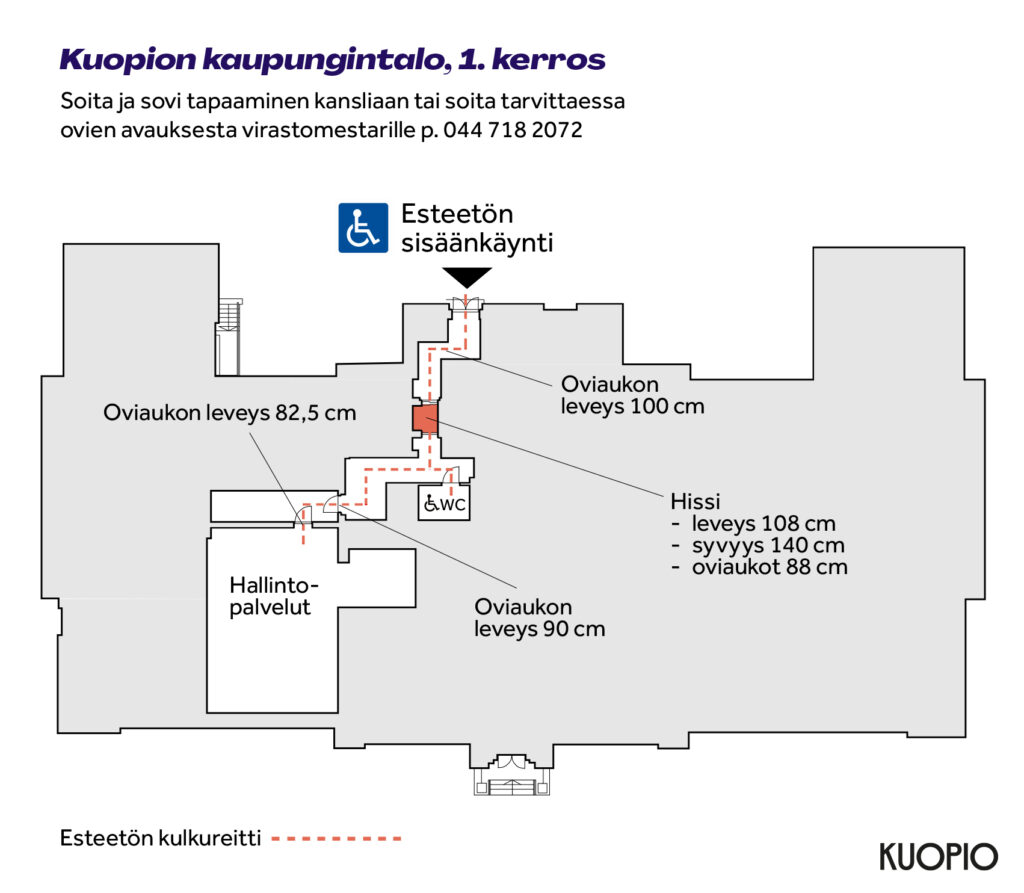
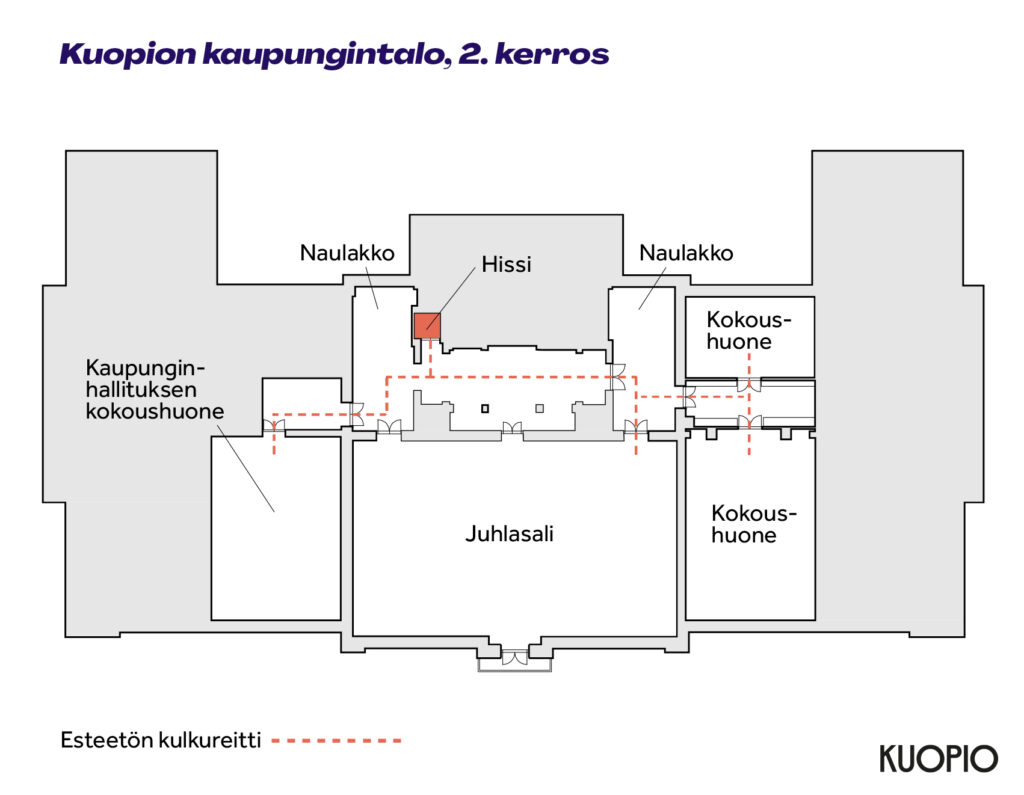
Lisätietoja
Marko Kostilainen
virastomestari
Hallintopalvelu
Jari Rusanen
iltavahtimestari
Hallintopalvelu